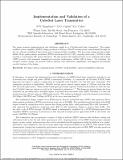| dc.contributor.author | Kingsbury, R. W. | |
| dc.contributor.author | Caplan, D. O. | |
| dc.contributor.author | Cahoy, K. L. | |
| dc.date.accessioned | 2017-08-15T18:37:24Z | |
| dc.date.available | 2017-08-15T18:37:24Z | |
| dc.date.issued | 2016 | |
| dc.identifier.issn | 0277-786X | |
| dc.identifier.uri | http://hdl.handle.net/1721.1/110953 | |
| dc.description.abstract | The paper presents implementation and validation results for a CubeSat-scale laser transmitter. The master oscillator power amplifier (MOPA) design produces a 1550 nm, 200mW average power optical signal through the use of a directly modulated laser diode and a commercial fiber amplifier. The prototype design produces high-fidelity M-ary pulse position modulated (PPM) waveforms (M=8 to 128), targeting data rates > 10 Mbit/s while meeting a constraining 8W power allocation. We also present the implementation of an avalanche photodiode (APD) receiver with measured transmitter-to-receiver performance within 3 dB of theory. Via loopback, the compact receiver design can provide built-in self-test and calibration capabilities, and supports incremental on-orbit testing of the design. | en_US |
| dc.language.iso | en_US | en_US |
| dc.publisher | SPIE | en_US |
| dc.subject | built-in self-test | en_US |
| dc.subject | receiver design | en_US |
| dc.subject | APD receiver | en_US |
| dc.subject | avalanche photodiode receiver | en_US |
| dc.subject | PPM | en_US |
| dc.subject | M-ary pulse position modulated | en_US |
| dc.subject | commercial fiber amplifier | en_US |
| dc.subject | directly modulated laser diode | en_US |
| dc.subject | MOPA design | en_US |
| dc.subject | master oscillator power amplifier design | en_US |
| dc.subject | CubeSat laser transmitter | en_US |
| dc.subject | power 200 mW | en_US |
| dc.title | Implementation and validation of a CubeSat laser transmitter | en_US |
| dc.type | Article | en_US |
| dc.identifier.citation | Kingsbury, R., Caplan, D., & Cahoy, K. (2016). Implementation and validation of a CubeSat laser transmitter. Proceedings Of The SPIE, 9739973905. doi:10.1117/12.2217990 | en_US |
| dc.contributor.department | Space Telecommunications Astronomy and Radiation (STAR) Lab | |
| dc.contributor.department | Massachusetts Institute of Technology. Department of Aeronautics and Astronautics | |
